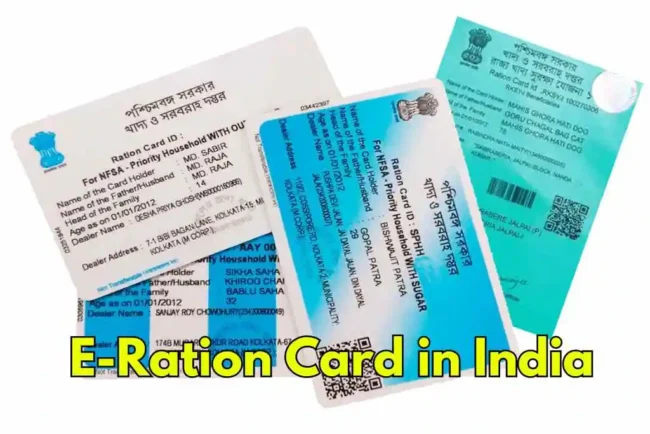E-Ration System in India: A Comprehensive Look
E-rationing, also known as Public Distribution System (PDS) automation, refers to the use of technology to streamline the distribution of subsidized food grains and other essential commodities to beneficiaries in India. Here’s a breakdown of the system:

Historical Context:
The PDS dates back to the 1960s, established to ensure food security during times of scarcity. Initially, it relied on manual record-keeping and physical distribution through fair price shops (FPS) – ration shops run by government-appointed retailers. However, this system faced issues like corruption, diversion of supplies, and difficulty in targeting beneficiaries accurately.
The Rise of E-Rationing:
In the late 2000s and early 2010s, various state governments initiated e-rationing projects to address these problems. The main goals of e-rationing were:
- Improved Targeting: By linking beneficiary identification with Aadhaar (a unique biometric ID system) or other identification methods, e-rationing aims to eliminate duplicate entries and ensure only eligible individuals receive rations.
- Enhanced Transparency: Electronic transactions allow for real-time monitoring of grain movement from central storage to FPS and ultimately to beneficiaries. This helps reduce leakages and black marketeering.
- Increased Efficiency: Automation simplifies record-keeping, reduces paperwork, and expedites distribution processes.
Read Also
International Day of Yoga 2024: A Journey of Mind, Body, and Society
Key Components of E-Rationing:
- Beneficiary Identification: Beneficiaries are registered by linking their Aadhaar or other IDs to the PDS database.
- Allocation and Offtake Management: The central government allocates subsidized grains to states based on their population. States then distribute quotas to FPS based on the number of registered beneficiaries.
- Point-of-Sale (PoS) Devices: FPS are equipped with PoS machines to authenticate beneficiaries and record transactions electronically.
- Electronic Payment Systems: Some states have introduced cashless transactions through electronic bank transfers or pre-paid cards.
Benefits of E-Rationing:
- Reduced Corruption: By minimizing manual intervention, e-rationing reduces opportunities for pilferage and diversion.
- Improved Targeting: Ensures subsidized food reaches the intended beneficiaries, especially the most vulnerable sections.
- Enhanced Transparency: Real-time data allows for better monitoring and accountability in the system.
- Streamlined Distribution: Automation simplifies the distribution process, reducing delays and improving efficiency.
Challenges and Concerns:
- Technological Infrastructure: Uneven internet connectivity and lack of proper infrastructure in rural areas can pose implementation hurdles.
- Digital Divide: Excluding those lacking access to technology or facing literacy issues may lead to unintended exclusion.
- Data Privacy: Concerns exist regarding data security and potential misuse of sensitive information linked to Aadhaar.
- Operational Issues: Technical glitches in PoS machines and power outages can disrupt distribution.
Current Status and Future Outlook:
E-rationing is still evolving. While some states like Andhra Pradesh and Gujarat have achieved significant success, others face implementation challenges. The central government is actively promoting e-rationing through initiatives like the One Nation One Ration Card (ONORC) scheme, allowing beneficiaries to access rations from any FPS across India.
Looking Forward:
- Improved Infrastructure: Expanding internet coverage and providing reliable electricity to rural areas are crucial for successful e-rationing implementation.
- Capacity Building: Ensuring smooth use of PoS machines and digital literacy among beneficiaries is essential.
- Data Security Measures: Robust data protection measures must be in place to address privacy concerns.
- Flexibility: Catering to beneficiaries lacking digital access requires alternative identification methods.
Conclusion:
E-rationing holds immense potential to transform the PDS in India and improve food security for millions. However, addressing the existing challenges and continuously improving the system are crucial to ensure its success. Collaboration between central and state governments, along with addressing the needs of vulnerable populations, will be key to a more efficient and equitable food distribution system.
Read More
Additional Information:
- For a deeper dive into specific state-level implementations, you can search for reports by government agencies and research institutions.
- Initiatives like “Aadhaar and PDS Integration for Leakage-proof Delivery” by the World Bank https://blogs.worldbank.org/en/voices/giving-people-control-over-their-data-can-transform-development provide insights into the potential of e-rationing.
- I hope this comprehensive overview provides you with valuable insights into e-rationing in India.
How to ration card and Aadhar card link
There are two main ways to link your Aadhaar card with your ration card in India:
Online Linking:
- Visit the official website of your state’s Public Distribution System (PDS) portal. Here’s a general search to find your state’s PDS portal: https://nfsa.gov.in/portal/ration_card_state_portals_aa
- Look for a section on Aadhaar seeding or linking.
- Enter your ration card number, Aadhaar card number, and your registered mobile number (linked to Aadhaar).
- You might receive a One-Time Password (OTP) on your mobile for verification.
- Submit the details and follow the on-screen instructions to complete the linking process.
- Offline Linking:
Visit your nearest Fair Price Shop (FPS) or ration shop.
- Carry photocopies of your ration card and Aadhaar card (for all family members on the card).
- You might also need a passport-sized photograph of the head of the family.
- If your bank account isn’t linked to Aadhaar, carry a copy of your bank passbook.
- Submit the documents to the FPS representative. They might perform fingerprint authentication for Aadhaar verification.
Additional Notes:
- The specific steps might vary slightly depending on your state.
- If you face any difficulties, ask the FPS representative or contact your local PDS department for assistance.
- Some states might offer SMS-based linking. Check your state’s PDS portal for details.
